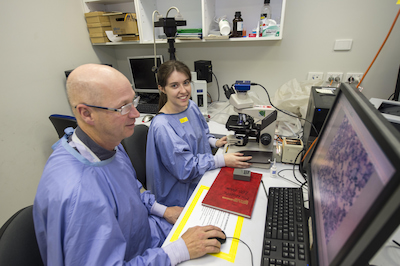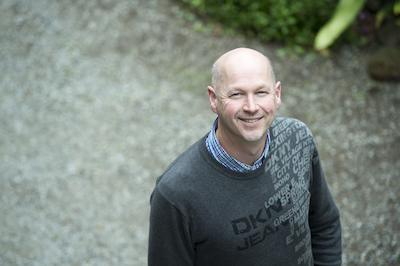Planned clinical trial offers access to new therapy for rare acute leukaemia
Professor David Curtis has focused his research on searching for new ways to treat early T-cell precursor acute lymphoblastic leukaemia (ETP-ALL) which he describes as “a nasty type of leukaemia”.

His most important discovery, he says, is the description of the cells that give rise to ETP-ALL.
He hopes to “pioneer new treatments” that translate to clinical trials, the first being a clinical trial for people who have relapsed with this form of blood cancer in a bid to increase the cure rate without having a stem cell transplant.
“ETP-ALL has the worst prognosis because it’s highly resistant to current treatments,” explained Prof. Curtis, a senior bone marrow transplant physician at Alfred Health, a Monash University-based researcher, and head of the Division of Blood Cancer Research at the Australian Centre for Blood Diseases. Read more about Professor Curtis here.
“I’ve been working on this for the last 10 years, developing a pre-clinical model with this type of leukaemia, and using it to find new ways of treating ETP-ALL, testing these, and then translating that into clinical trials for people with this type of leukaemia.
“In the first instance, it’ll be for people that have relapsed or are resistant to the current treatments, which is generally high doses of chemotherapy.”
Prof. Curtis said ETP-ALL is a rare disease that accounts for “one in 10 people who get acute lymphoblastic leukaemia (ALL)” – that’s about 10-20 children and adults per year.
“It’s more common in adults and it’s more common in the relapsed setting because it is fundamentally a very resistant disease.

“And the origin of the leukaemia is different in children and adults,” Prof. Curtis explained.
“This may be because this type of leukaemia is more like a stem cell, and as we age leukaemias that arise in adults tend to come from stem cells. It’s the same with acute myeloid leukaemia (AML); that’s a stem cell leukaemia, and that why it’s more common in adults.
“Children that get ETP-cell ALL do quite well still because they tolerate high doses of chemotherapy, but it’s a particular problem in younger adults, older than 16 or 17, and it’s a major problem in older adults because you can’t give them really high doses of treatment,” he said.
“You need to give very high doses of chemotherapy to get reasonable cure rates. Overall, the cure rate is about 60%, unlike most ALLs in children, where it’s about 80 to 90%.
“If it comes back, so if it relapses, the long- term cure is only 10%,” said Prof. Curtis.
Current treatment for ETP-ALL is the same as all the other ALLs.
“That’s one of the reasons why we need new treatments, because that standard of care isn’t as effective in ETP-ALL as it is in other ALLs.”
Clinical trials overseas are testing venetoclax (Venclexta®, a BCL-2 inhibitor) and ruxolitinib (Jakavi®, a kinase inhibitor); treatments selected based on the sort of studies Prof. Curtis does in his lab to identify new treatments.
At the New Directions in Leukaemia Research meeting in Brisbane*, (30 May-1 June 2022), Prof. Curtis talked about a new treatment for ETP-ALL using gilteritinib (Xospata®), an inhibitor of FLT3; mutations of FLT3 are very common in this type of leukaemia.
“Mutations seen in ETP-ALL are actually more like those in acute myeloid leukaemia because this is a really immature stem cell type leukaemia,” said Prof. Curtis.
He has tested gilteritinib in his lab and is keen to get an investigator-driven clinical trial underway.
“It works quite effectively, so we’ve got very good scientific rationale, or reason, to test gilteritinib in humans, but it’s hard to get pharmaceutical companies to go off track,” said Prof. Curtis.
“The obstacle is getting pharmaceutical support because ETP-ALL is too rare a disease.”
“If we can’t get gilteritinib from the manufacturing company, then we’ll look at alternative inhibitors of FLT3, from other companies,” he said.
The proposed ETP-ALL trial will be run through the Australasian Leukaemia & Lymphoma Group – Australia’s leading collaborative blood cancer clinical trials research group.
Prof. Curtis explained that normally, when someone with ETP-ALL gets relapsed disease, they are given salvage chemotherapy with an attempt to get them to transplant.
“Chemotherapy alone is effective only in about 30% of people. What we are proposing is to add in a FLT3 inhibitor, such as gilteritinib, which we believe will increase the chances of that person getting into remission and being able to have a transplant,” he said.
“The sequence of translation or clinical development would be to show that there’s some benefit using this protocol in the relapse setting, and once that is proven, the proposal would be to test it upfront, in people when they present with ETP-ALL.
“The hope or expectation would be to use a FLT3 inhibitor, such as gilteritinib, with chemotherapy, to increase the cure rate for those people, without a transplant.”
Prof. Curtis describes himself as “a transplanter… that’s what I do”.
“I’m trying to put myself out of business,” he said, and he hopes he’ll be successful at that.
*At NDLR, Australia’s top scientists and haematologists, and international speakers come together to solve problems and come up with better therapies for blood cancers. NDLR is held every two years and has been supported by the Leukaemia Foundation since the first meeting in 2006.
Last updated on January 3rd, 2023
Developed by the Leukaemia Foundation in consultation with people living with a blood cancer, Leukaemia Foundation support staff, haematology nursing staff and/or Australian clinical haematologists. This content is provided for information purposes only and we urge you to always seek advice from a registered health care professional for diagnosis, treatment and answers to your medical questions, including the suitability of a particular therapy, service, product or treatment in your circumstances. The Leukaemia Foundation shall not bear any liability for any person relying on the materials contained on this website.